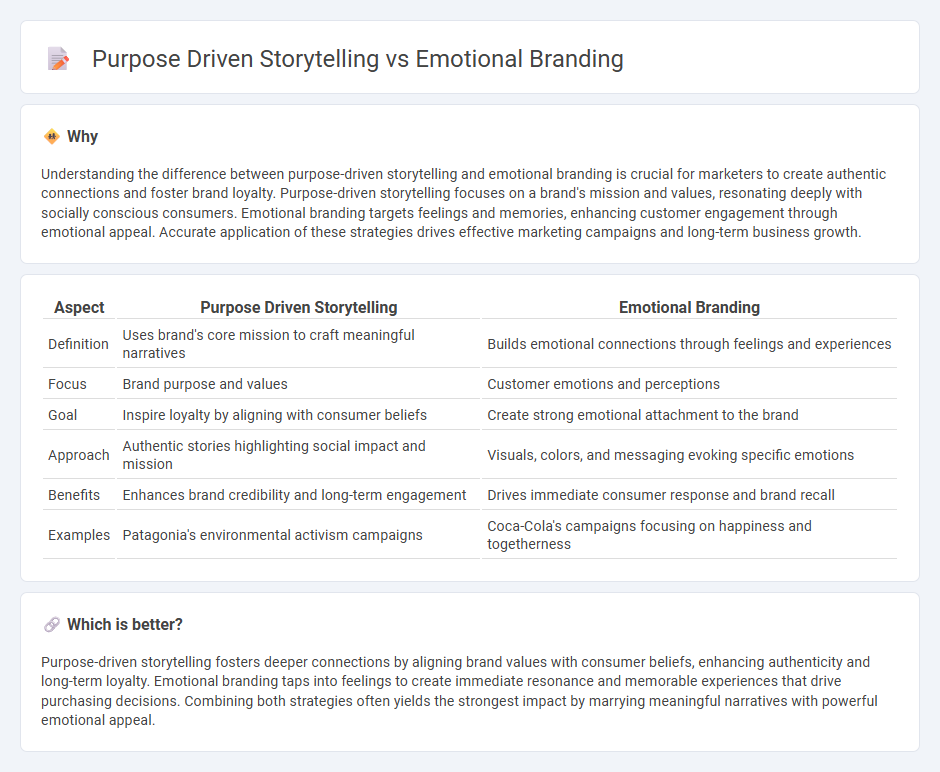
Purpose-driven storytelling focuses on conveying a brand's core mission and values to create meaningful connections with socially conscious consumers. Emotional branding, on the other hand, taps into feelings and experiences to foster loyalty and evoke strong personal attachments. Explore how these strategies transform brand perception and influence purchasing behavior.
Why it is important
Understanding the difference between purpose-driven storytelling and emotional branding is crucial for marketers to create authentic connections and foster brand loyalty. Purpose-driven storytelling focuses on a brand's mission and values, resonating deeply with socially conscious consumers. Emotional branding targets feelings and memories, enhancing customer engagement through emotional appeal. Accurate application of these strategies drives effective marketing campaigns and long-term business growth.
Comparison Table
| Aspect | Purpose Driven Storytelling | Emotional Branding |
|---|---|---|
| Definition | Uses brand's core mission to craft meaningful narratives | Builds emotional connections through feelings and experiences |
| Focus | Brand purpose and values | Customer emotions and perceptions |
| Goal | Inspire loyalty by aligning with consumer beliefs | Create strong emotional attachment to the brand |
| Approach | Authentic stories highlighting social impact and mission | Visuals, colors, and messaging evoking specific emotions |
| Benefits | Enhances brand credibility and long-term engagement | Drives immediate consumer response and brand recall |
| Examples | Patagonia's environmental activism campaigns | Coca-Cola's campaigns focusing on happiness and togetherness |
Which is better?
Purpose-driven storytelling fosters deeper connections by aligning brand values with consumer beliefs, enhancing authenticity and long-term loyalty. Emotional branding taps into feelings to create immediate resonance and memorable experiences that drive purchasing decisions. Combining both strategies often yields the strongest impact by marrying meaningful narratives with powerful emotional appeal.
Connection
Purpose-driven storytelling and emotional branding are interconnected by their ability to create deep, meaningful connections between a brand and its audience. Purpose-driven storytelling emphasizes the brand's core values and mission, fostering trust and authenticity, while emotional branding taps into consumers' feelings, driving loyalty and engagement. Together, they enhance brand identity and stimulate consumer behavior through compelling narratives that resonate on a personal level.
Key Terms
**Emotional Branding:**
Emotional branding leverages deep psychological connections by tapping into consumers' feelings, memories, and aspirations to create lasting loyalty and brand affinity. By using sensory experiences, compelling visuals, and relatable narratives, emotional branding fosters trust and drives consumer behavior beyond rational benefits. Discover how emotional branding can transform your marketing strategy and build meaningful customer relationships.
Emotional connection
Emotional branding creates deep connections by tapping into consumers' feelings and experiences, fostering loyalty and trust. Purpose-driven storytelling highlights a brand's mission and values, inspiring audiences through meaningful narratives aligned with social causes. Explore how these strategies enhance customer engagement and build authentic brand relationships.
Brand loyalty
Emotional branding builds brand loyalty by forging deep, personal connections that resonate with consumers' feelings and experiences, creating lasting bonds. Purpose-driven storytelling enhances loyalty by aligning the brand with meaningful values and social causes, fostering trust and shared identity with audiences. Explore how integrating both strategies can maximize customer engagement and long-term loyalty.
Source and External Links
Emotional branding - Emotional branding is the marketing practice of building brands that appeal directly to consumers' emotional states, needs, and aspirations, creating strong, lasting attachments comparable to feelings of bonding or love with a brand.
Emotional Branding: Benefits & Examples - Ramotion - Emotional branding uses content, design, and campaigns to connect with a consumer's emotions such as joy, trust, or nostalgia to build long-term loyalty and influence decisions, exemplified by personalized campaigns like Coca-Cola's "Share a Coke".
Emotional Branding: How to Win Hearts and Minds - Emotional branding focuses on resonating with consumers on a deeper, personal level by telling stories about customer struggles and advocating for social responsibility to create meaningful, emotional connections.
 dowidth.com
dowidth.com